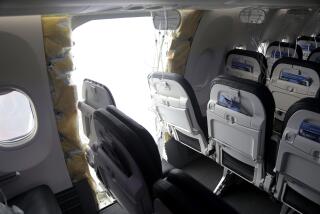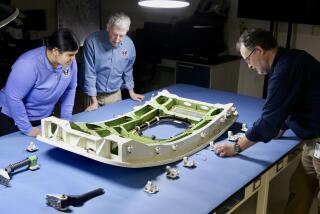Boeing Says Crashed Japan 747 Was Incorrectly Repaired in ’78
- Share via
SEATTLE — Boeing Co. said Friday that the Japan Air Lines 747 jetliner that crashed into a mountain last month and killed 520 people had been incorrectly repaired after a less serious accident in 1978.
Although Boeing acknowledged that part of its repair job seven years ago had been faulty, it said that the cause of the Aug. 12 crash, the worst single-plane accident in history, is still not known.
The company described the problem with the repairs in a letter written Friday that was being sent to airlines that fly its 747 aircraft. It made the letter available to the press.
The letter also said that inspections of nearly half of the 747 fleet currently in the air “show no evidence that would suggest any problem with the basic design, manufacture or structural integrity” of the plane.
The JAL plane slammed into the mountain in central Japan during a Tokyo-to-Osaka flight, after part of the tail fin broke apart and the pilot lost control of the plane.
Boeing said its examination of the JAL wreckage showed that “a decompression occurred in flight due to a rupture of the aft pressure bulkhead.”
The aft pressure bulkhead is an umbrella-shaped barrier which separates the pressurized cabin from the unpressurized tail cone of the plane.
The bulkhead consists of 36 curved triangular panels. The edges of each panel overlap to provide a double-strength bond, a Boeing spokesman explained. The area of overlap is called the bulkhead splice.
In addition, a third piece of metal, called a splice plate, is inserted as reinforcement between each of the edges, and all three layers are riveted in place, he said.
In the letter, Boeing said that a relatively small section of the bulkhead splice was not correctly assembled during a repair which Boeing made after a 1978 accident.
Boeing said a splice plate was incorrectly installed so that it was held by two rows of rivets rather than the normal three rows. One of three rows of rivets did not pass through the splice plate, in effect making the section weaker rather than stronger, a Boeing spokesman said.
These splice plates are not installed in Boeing planes during factory assembly and would only be used as part of an unusual repair job. As a result, a similar repair problem in other planes would be “extremely rare,” a spokesman said.
The company said two of its metallurgists are in Japan along with personnel from the U.S. National Air Transportation Safety Board to obtain casts of the fractured surfaces in the small section of the bulkhead splice.
The casts will be analyzed to determine whether the incorrect repair contributed to the accident, Boeing said. A spokesman said the analysis should be ready by the end of next week.
Boeing also said further investigation will involve a continued search for additional wreckage and examination of the debris once it is removed from the crash site and reassembled.
The repairs in 1978 followed a rough landing at Osaka, when 25 people were injured when the jet’s tail dragged along a runway for 1,200 feet.
More to Read
Inside the business of entertainment
The Wide Shot brings you news, analysis and insights on everything from streaming wars to production — and what it all means for the future.
You may occasionally receive promotional content from the Los Angeles Times.










